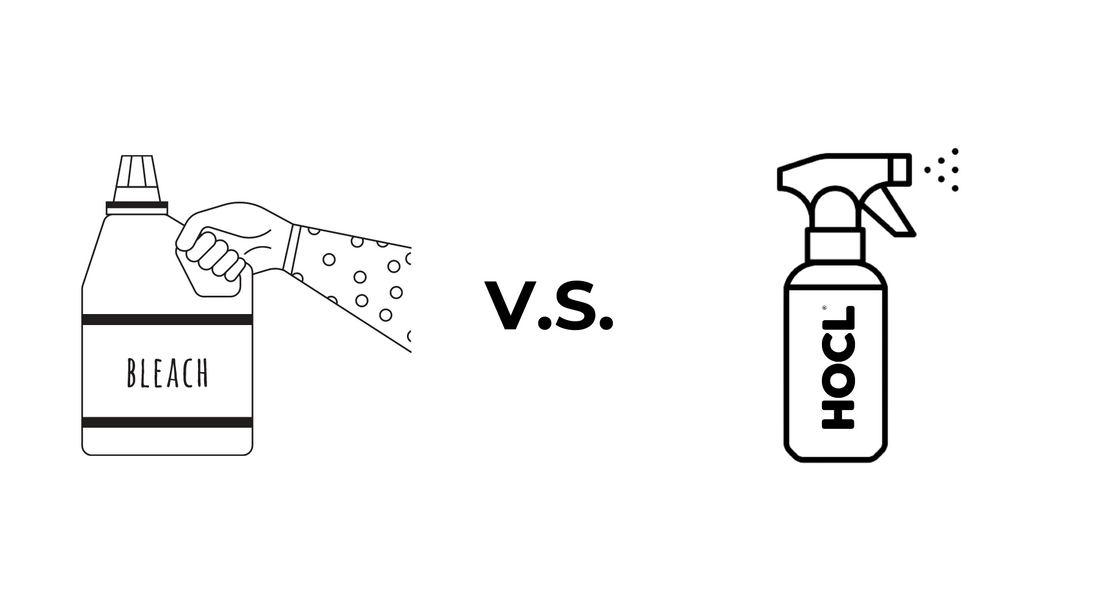See below, as to an explanation as to the difference between hypochlorous acid or electrochemically activated water and bleach?
Hypochlorous Acid (HOCL)
- Chemical Nature: Hypochlorous acid is a weak acid formed when chlorine dissolves in water. Its chemical formula is HOCl.
- Properties: It is a powerful oxidizing agent with strong disinfecting properties. It is also produced naturally by the human immune system to kill pathogens.
- Uses: Due to its strong disinfecting properties and low toxicity, it is used in medical settings for wound care, in food processing to sanitize surfaces, and in water treatment.
Bleach (Sodium Hypochlorite, NaOCl)
- Chemical Nature: Bleach typically refers to a solution of sodium hypochlorite in water. The chemical formula for sodium hypochlorite is NaOCl.
- Properties: Sodium hypochlorite is also a strong oxidizing agent and disinfectant. It is more stable in solution compared to hypochlorous acid, especially at higher pH levels.
- Uses: Bleach is commonly used for household cleaning, laundry, and disinfecting surfaces. It is also used in water treatment and industrial applications.
Relationship and Differences
- Formation: When sodium hypochlorite is dissolved in water, it can form hypochlorous acid depending on the pH of the solution. In an aqueous solution, NaOCl dissociates into Na+ and OCl-, and OCl- can react with water to form HOCl.
- pH Dependence: The concentration of hypochlorous acid in a sodium hypochlorite solution is highly dependent on the pH. At lower pH levels (acidic conditions), more HOCl is present, while at higher pH levels (basic conditions), more OCl- (hypochlorite ion) is present.
- Effectiveness: HOCl is a more effective disinfectant than OCl- because it is more reactive and can more easily penetrate the cell walls of microorganisms.
- Safety: Hypochlorous acid is less irritating and safer for use on skin and mucous membranes compared to sodium hypochlorite solutions.
Hypochlorous Acid's Superior Effectiveness
- Molecular Structure: Hypochlorous acid is a small, neutral molecule, allowing it to penetrate microbial cell walls more easily than the hypochlorite ion, which is larger and negatively charged.
- Oxidizing Power: HOCL is a powerful oxidizing agent. It can oxidize and disrupt essential cellular components of microorganisms, such as proteins, lipids, and nucleic acids, leading to cell death.
- Broad Spectrum: HOCL is effective against a wide range of microorganisms, including bacteria, viruses, and fungi. Its broad-spectrum activity makes it suitable for various disinfection applications.
- Fast Action: Hypochlorous acid acts quickly, often killing pathogens within seconds to minutes. This rapid action is crucial in environments where immediate disinfection is necessary, such as healthcare settings and food processing industries.
- Stability and Activity: HOCL is most effective at a pH range of 4-6, where it remains in its undissociated form. At higher pH levels, it dissociates to form the less effective hypochlorite ion (OCl-). This pH sensitivity ensures that HOCL solutions are highly active in mildly acidic conditions.
- Lower Concentration: Due to its high reactivity and effectiveness, HOCL can be used at lower concentrations compared to sodium hypochlorite solutions. This reduces the risk of irritation and chemical damage to surfaces and materials.
- Human Safety: Hypochlorous acid is less irritating to skin and mucous membranes compared to sodium hypochlorite. This makes it safer for use in environments where contact with humans is likely, such as wound care and hand sanitizers.
- Environmental Impact: HOCL breaks down into harmless components (water and salt) after use, making it an environmentally friendly disinfectant. It leaves no harmful residues, which is beneficial for applications in food processing and water treatment.
Practical Applications
- Healthcare: Hypochlorous acid is used in wound care to clean and disinfect wounds without causing irritation or damage to tissues. Its effectiveness and safety profile make it ideal for use in hospitals and clinics.
- Food Industry: HOCL is used to sanitize food contact surfaces and equipment, reducing the risk of foodborne illnesses. Its ability to disinfect without leaving harmful residues ensures the safety of food products.
- Water Treatment: Hypochlorous acid is used in water treatment processes to disinfect drinking water and swimming pools. Its effectiveness in killing pathogens ensures safe and clean water for consumption and recreation.
Hypochlorous acid's superior effectiveness as a disinfectant is attributed to its chemical properties, rapid action, broad-spectrum activity, safety profile, and environmental friendliness. These characteristics make it a preferred choice in various industries and applications where efficient and safe disinfection is paramount.

